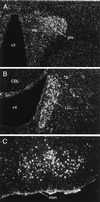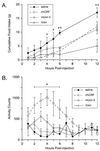Urocortin II: a member of the corticotropin-releasing factor (CRF) neuropeptide family that is selectively bound by type 2 CRF receptors
- PMID: 11226328
- PMCID: PMC30227
- DOI: 10.1073/pnas.051626398
Urocortin II: a member of the corticotropin-releasing factor (CRF) neuropeptide family that is selectively bound by type 2 CRF receptors
Abstract
Here we describe the cloning and initial characterization of a previously unidentified CRF-related neuropeptide, urocortin II (Ucn II). Searches of the public human genome database identified a region with significant sequence homology to the CRF neuropeptide family. By using homologous primers deduced from the human sequence, a mouse cDNA was isolated from whole brain poly(A)(+) RNA that encodes a predicted 38-aa peptide, structurally related to the other known mammalian family members, CRF and Ucn. Ucn II binds selectively to the type 2 CRF receptor (CRF-R2), with no appreciable activity on CRF-R1. Transcripts encoding Ucn II are expressed in discrete regions of the rodent central nervous system, including stress-related cell groups in the hypothalamus (paraventricular and arcuate nuclei) and brainstem (locus coeruleus). Central administration of 1-10 microg of peptide elicits activational responses (Fos induction) preferentially within a core circuitry subserving autonomic and neuroendocrine regulation, but whose overall pattern does not broadly mimic the CRF-R2 distribution. Behaviorally, central Ucn II attenuates nighttime feeding, with a time course distinct from that seen in response to CRF. In contrast to CRF, however, central Ucn II failed to increase gross motor activity. These findings identify Ucn II as a new member of the CRF family of neuropeptides, which is expressed centrally and binds selectively to CRF-R2. Initial functional studies are consistent with Ucn II involvement in central autonomic and appetitive control, but not in generalized behavioral activation.
Figures




References
-
- Vale W, Spiess J, Rivier C, Rivier J. Science. 1981;213:1394–1397. - PubMed
-
- Menzaghi F, Heinrichs S C, Pich E M, Weiss R, Koob G F. Ann NY Acad Sci. 1993;697:142–154. - PubMed
-
- Sawchenko P E, Imaki T, Potter E, Kovacs K, Imaki J, Vale W. Ciba Found Symp. 1993;172:5–21. - PubMed
-
- Herkenham M. Neuroscience. 1987;23:1–38. - PubMed
Publication types
MeSH terms
Substances
Associated data
- Actions
Grants and funding
LinkOut - more resources
Full Text Sources
Other Literature Sources
Molecular Biology Databases

